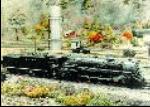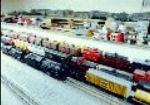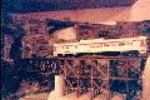The American OO Gauge SIG was formed in the fall of 1985 and is dedicated to the preservation and advancement of American OO gauge, which has a scale of 4mm=1ft. and a track gauge of 19 mm, essentially 0.75 in. This scale, which is slightly larger than HO scale, flourished in the 1930s through the mid-1950s. Manufacturers of American OO included many of the most famous model companies--Lionel, Mantua, Scale Craft, and j-c Models, among others. A small but devoted group of modelers continues in this scale, and wishes to help others and to foster interest in OO gauge modeling.
The primary activity of the SIG is the publication of a quarterly newsletter, The OO Road. The contact person for membership in the SIG, which includes a subscription to the newsletter, is:
Paul Magnussen
3115 S. 11th St.
Tacoma, WA 98405
(253) 272-9069
Dues are $7.00 per year for members of the NMRA, and $10.00 per year for nonmembers if they wish a hard paper copy, but no dues are required for those who receive the newsletter via email. The newsletter is published quarterly for the period January through December.
Issues of the newsletter may include articles on building and rebuilding OO kits and ready-to-run equipment, new products that can be used with OO scale, track laying, layout operation, and construction of modern equipment depending on what members submit for publication. A swap column also appears, and the SIG maintains a pool of items to help newcomers to the scale. And a list of members is published annually, promoting contacts and fellowship with are members spread all over the U. S. and Canada. While not primarily catering to the Lionel OO collector, those who have an interest in collecting older OO items can often find them through the newsletter. Some articles describing older lines of OO items, and OO manufacturers and modelers, also may appear.
 A Scale-Craft 4-8-4, built from a kit, on Pierre Bourassa's layout. (77K)
A Scale-Craft 4-8-4, built from a kit, on Pierre Bourassa's layout. (77K)
Naturally one major segment of SIG membership consists of persons modeling the late steam era of the 1930s to the 1950s, as this is the period in which most OO manufacturing took place. Equipment includes the Nason and Lionel Hudsons, the Reading consolidation, a mammoth Northern, GG-1s and other electrics, and early box cab and streamlined diesels. Cars include heavyweights and early streamliners, and the colorful freight cars of the period. But in addition many current modelers create modern layouts, building much from scratch, but also converting the latest prototype models in HO (3.5mm=1ft, 16.5mm gauge) -- intermodal cars and 4000hp diesels -- to the slightly larger OO scale. In fact, much HO is oversize, for a variety of reasons including motors too wide for modern diesel hoods, so the conversion is a natural.
So if you are looking for something a bit different, and enjoy older kits of wood, cardstock and brass instead of plastic, or wish to scratch-build and kit-bash in plastic, then OO may be for you.
 A scene on Bud Spice's layout with 2 fat-boilered Reading 2-8-0's ready for a coal drag, in front of a long classification yard. (67K)
A scene on Bud Spice's layout with 2 fat-boilered Reading 2-8-0's ready for a coal drag, in front of a long classification yard. (67K)
Most items for OO were made in the 1930-60 era, so the primary source of rolling stock and track is other modelers. Many SIG members have large stocks, and share with others. Most locos and cars are available as built-up, used items, and a wide variety is available in ready-to-run form as well as needing some work, with prices varying accordingly. Many kits are still available as well, particularly from the Scale-Craft (SC) line (later sold by Kemtron), which includes die cast locomotives and cars that are similar to current HO kits (fairly easy to build with files and screwdriver). This is the line that Lionel copied in creating its line, and the SC passenger and freight cars are a perfect complement to the Lionel detailed Hudson. Also in good supply are freight and passenger car kits with wood bodies and printed, embossed card sides, by such firms as j-c Models and SC. And one of the largest manufacturers of model trains, Bowser, has a selection of detail parts in soft metal for OO, from passenger car steps to freight car end sills and roof details. These are sold through English's Model Railroad Supply. Most OOers probably use Kadee couplers, which are close to scale in OO, while some choose to use the dummy knuckle couplers that came with Lionel and Scale Craft rolling stock.
Track is also often available used, particularly Tru-Scale, but many prefer to use the currently available line of turnouts from BK Enterprises along with hand laid trackage between switches. Another possibility is to use On3 track and switches, as the gauge and clearances for this is perfectly compatible with OO, thanks to the NMRA's standards for these items. On3 uses a track gauge of 0.75in, almost exactly identical to OO's 19mm.
As mentioned, much HO is really OO scale bodies on HO wheelsets. These include the Mantua 4-6-0 Ten-Wheeler, the Mantua side rod 4-wheel diesel switcher (an easy conversion) and the IHC (formerly AHM) 4-wheel and 6-wheel diesels. The Fleischmann ALCO FA covered wagon diesels and their Baldwin 8-wheel switcher bodies are also almost exactly OO scale. As for cars, almost all of the modern very large cars look great on OO trucks, being just a bit larger than the typical OO car prototype dating from the 1930s. And modern HO trucks are easily converted to OO.
 Bill Johann likes modern diesels and cars, as this photo on his timetable-operated layout reveals. (56K)
Bill Johann likes modern diesels and cars, as this photo on his timetable-operated layout reveals. (56K)
Many modelers are aware that British HO often says OO on the box, or OO/HO. The reason is that in the 1920s and 1930s, when HO and OO were being developed, there was much confusion over scale and gauge. For a variety of reasons, while American manufacturers sorted this out so that gauge and scale were consistent, the British opted for the OO scale of 4mm on HO gauge track. This became the standard, and has remained so with most British prototype mass-produced trains since.
While this means that British OO/HO equipment is thus to the OO scale, and therefore could be used on an American OO layout, in fact most of it looks out of place. Most British trains are distinctly different from American ones in appearance. But the advent of very high speed trains with an international look means that these trains can be used on a modern American pike, and models of the British HSGT trains that travel up to 125 mph look fine on U.S. model tracks. And of course buildings, vehicles, and people made to the 4mm scale for British modelers work perfectly well also. Hornby is a major manufacturer of these products.
To provide some idea of the range of OO items, this sampler presents the names and selected products of a few manufacturers:
 The Schorr Budd RDC-3 crossing a trestle on Jacques Viau's layout. (77K)
The Schorr Budd RDC-3 crossing a trestle on Jacques Viau's layout. (77K)
In addition to The OO Road newsletter, the following illustrate what can be done in OO:
"The OO Scale Saint Anne," Railroad Model Craftsman, May 1979. Article contains 22 photos and plan of a superb OO layout.
"A History of American OO Gauge," in 2 parts, Train Collectors Quarterly, October 1986 and April 1987. Article traces the development of OO, describes most of the products made, and contains 22 photos illustrating all major manufacturers' lines.
Scans courtesy of Daniel S. Dawdy.